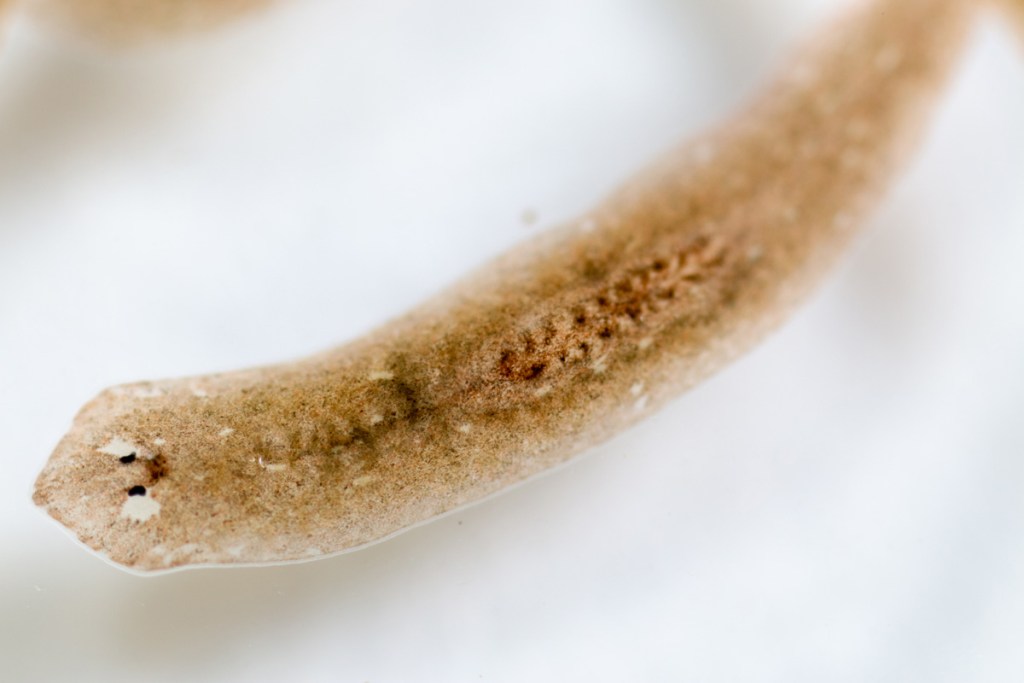It was a few weeks after adding live rock to his saltwater aquarium that longtime aquarist Jeff Kurtz noticed rust-colored flecks on one of the rocks and the glass nearby. In a Tropical Fish Magazine article, Kurtz writes that at first he thought the flecks were just a form of coralline algae. Then he realized that they were all the same shape and moving. Flatworms had invaded his fish tank. Flatworms can become a problem in any home aquarium. They typically hitch a ride into the fish tank on new materials like plants and rocks and can also be attached to fish or invertebrates introduced to the tank.

Types of flatworms seen in fish tanks
Several different types of flatworms can be found in home aquariums.
Rhabdocoela worms
These flatworms are tiny and seldom grow more than 0.2 inches in length. Aquatic specialists at Petco describe them as having rounded heads unlike the typical triangle-shaped head of the bigger flatworms. Their population growth is typically a result of too many nutrients in the tank.
Planaria
Planaria, also known as flatworms, can be found in both saltwater and freshwater environments. Petco specialists say that their color can vary: white, reddish-brown, black, and even pink based on what they are eating. They are only about 0.1 to 0.6 inches long with heads shaped like an arrowhead and two black dots for eyes. If cut into pieces, planaria are capable of regenerating a new worm from each piece.
Rust brown flatworms
According to aquatic specialists at LiveAquaria, this is the most common species of flatworm seen among saltwater aquarium hobbyists. They are tan, brown, or rust with a red dot and only reach about ¼ inch in length. Rust brown flatworms are oval and with what looks like two tiny tails protruding from behind. They are found on top of corals, and normally in areas of low flow in the reef aquarium. According to LiveAquaria, these flatworms will multiply rapidly in tanks with elevated nutrient levels.
Acropora-eating flatworms
Acropora-eating flatworms look like brown ovals and are almost impossible to spot on corals, say specialists at Reef Builders. They survive by eating the tissue of Acropora corals and lay their eggs at the base of the coral skeletons.
Are flatworms harmful to fish?
Petco specialists say that rhabdocoela flatworms feed on bacteria and microalgae and are harmless to aquatic life. And while planaria won’t typically attach to a swimming fish or fast-moving invertebrate, Petco specialists say that they may take a bite out of an unsuspecting resting shrimp or fish. These flatworms also prey on fish eggs and babies, and may target weaker fish in the tank. According to LiveAquaria, the population of rust-brown flatworms perched on corals in a saltwater aquarium can increase to a point where they block the light from reaching the coral’s tissue. Acropora-eating flatworms in a marine aquarium can rapidly eat and destroy Acropora corals.
How to get rid of flatworms in the tank
Here are some things you can do to remove flatworms from your aquarium.
Use fish to help with the problem.
Some hobbyists seek natural means of control such as adding compatible fish known to eat flatworms to their tanks. For example, angelfish, guppies, and goldfish are known to eat flatworms in freshwater aquariums. For saltwater aquariums, yellow coris wrasse, leopard wrasse, and blue damsels might help keep flatworms under control.
Manually removing the flatworms
Siphoning flatworms from the tank may help keep numbers under control. In his Tropical Fish Magazine article, Kurtz shares that with each partial water change he vacuumed up as many of the tiny worms as he could. The aquarist writes that eventually the population began to diminish and the flatworms “disappeared almost as abruptly as they arrived.”
Use planaria bait traps
Some aquarium hobbyists have had luck keeping infestations under control using planaria traps. For example, the Aquarium Supplies ISTA Clear Glass Planaria Trap got a 4-star review on Amazon. One Amazon customer reports that she baited a trap overnight with freeze-dried shrimp and the following morning it was full of flatworms.
Use a deworming chemical
There are a variety of dewormers on the market. The type you choose will depend in part on the type of flatworm in your tank. Experts at PetMD say hobbyists should reach out to a fish veterinarian about safety precautions before using any dewormer. Invertebrate species like snails and shrimp are particularly at risk and should be removed before using a chemical, according to PetMD. Additionally, silverfish, lionfish, piranhas, and bottom feeders may also have a negative reaction to deworming chemicals. And keep in mind that overusing dewormers can interfere with the ecosystem in your fish tank.

In the end, experts say that the best way to control flatworms is to prevent them from entering your tank in the first place. That includes keeping up with routine maintenance and quarantining all new fish and invertebrates before adding them to your aquarium. Any new plants or rocks should be thoroughly washed before putting them in the tank. It’s easy for tiny flatworms to escape your notice but by taking precautions you can reduce the risk of turning them loose in your aquarium.
Editors' Recommendations
- What causes high pH in an aquarium? We’ll walk you through getting your tank levels in check
- A simple guide to what to feed tadpoles in your aquarium
- What fish can live with bettas? These are your best bets for fish buddies
- Check these 3 things immediately if you have fish swimming at the top of the tank
- Can you make a profit breeding your bearded dragon?




